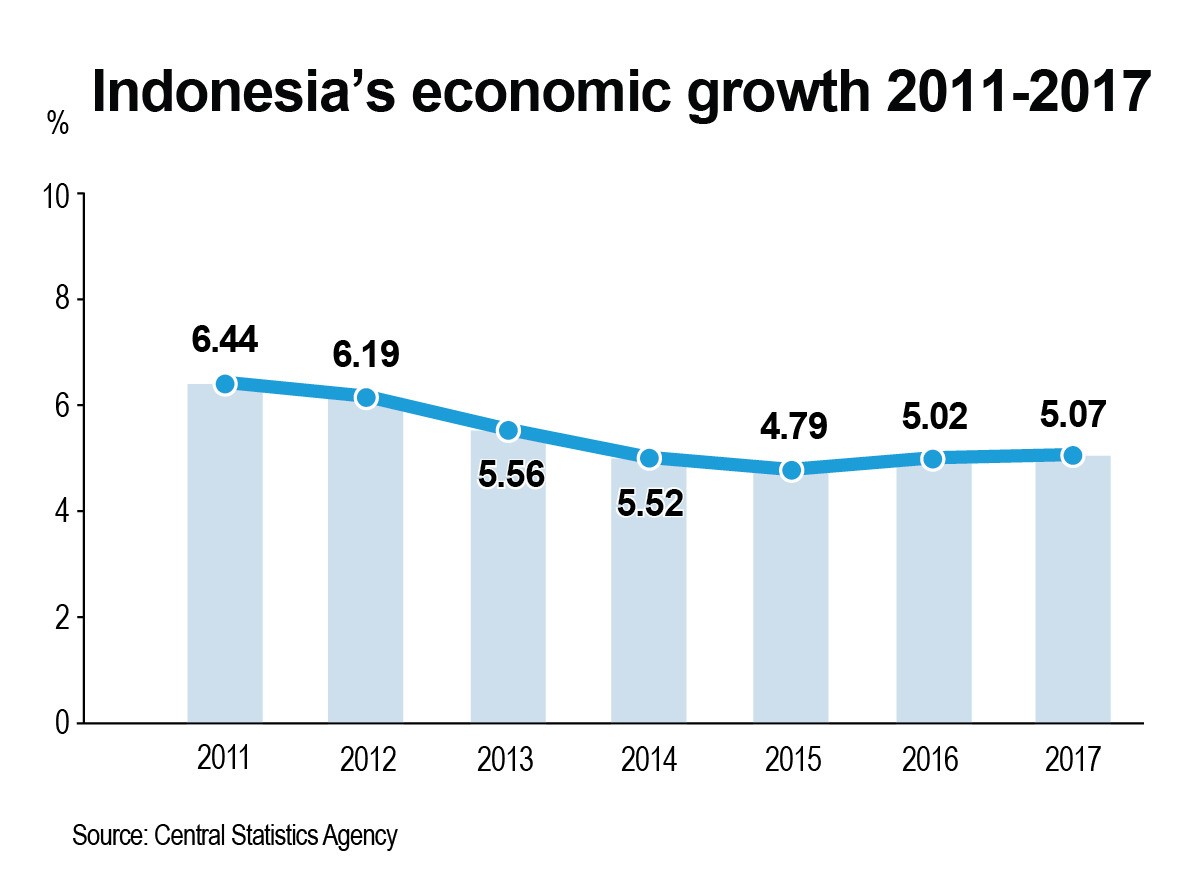
GDP growth of 5.16 percent or 5.17 percent – does it really matter?
Robert Z. Lawrence, a professor of international trade and investment at Harvard University, once joked during an international seminar in Jakarta that being an economist tasked with forecasting Indonesia’s economic growth was probably “the easiest job in the world”.
Lawrence’s joke was to highlight Indonesia’s consistent growth of around 5 percent over the last couple of years, which he said was stable compared to other countries. Statistics Indonesia (BPS) revealed that the last time Indonesia had recorded gross domestic product (GDP) growth below 5 percent was in 2015, when the economy expanded 4.79 percent year-on-year (yoy). In 2016 and 2017, GDP growth was recorded at 5.02 percent and 5.07 percent, respectively. The 2014 data, however, marked but a blip in the long-run trend, as Indonesia posted on average 5.3 percent GDP growth between 2000 and 2017, according to data compiled by the National Development Planning Board (Bappenas).
As if to prove Lawrence’s point, the country’s economists and government officials often come up with GDP growth projections that only differ in decimal fractions from one another. Finance Minister Sri Mulyani Indrawati, for example, expected the country’s economy to expand by 5.15 percent in 2018, which is slightly lower than 5.17 percent projected by Coordinating Economic Minister Darmin Nasution. The ministers’ projections were well below the 5.4 percent target stipulated in the 2018 state budget. The realized figure in 2018 was 5.17 percent as correctly predicted by Darmin. Maybank Indonesia economist Myrdal Gunarto projected 2018 GDP growth to fall between the two minister’s projection, at 5.16 percent.
But what is the significance between those decimal variations? The Jakarta Post asked several economists and a government official about the reason for it and its implications for macroeconomic indicators. Why do GDP growth projections differ only slightly in Indonesia? According to Pungky Sumadi, Bappenas deputy of population and manpower affairs, there is nothing extraordinary about people having different estimates, as they have their own subjective ways of looking at a set of data.“[Different growth projections] are closely related to the individual judgments of [the economists],” Pungky said. “The differences in those judgments mean the [economic growth projections] differ only slightly [from one another].”
 Construction plays a signifcant role in Indonesia's economy. (Shutterstock/File)
Construction plays a signifcant role in Indonesia's economy. (Shutterstock/File)
Do slight variations matter to the economy? Pungky said a deviation of less than 1 percent between projected and realized GDP growth had a minimal impact on key indicators, such as the unemployment figure, poverty rate or Gini ratio. The degree of sensitivity of those indicators to GDP growth changes constantly. He said various factors could influence those socioeconomic indicators, and it was hard to pin down the direct correlation between GDP growth and, for example, a declining unemployment rate.
To illustrate Pungky’s point, data compiled by Bappenas reveals that the elasticity between GDP growth and employment varies each year.in 2017, every 1 percent of GDP expansion opened 520,000 new employment opportunities. Meanwhile, in 2018 it was projected that 1 percent growth in GDP, would produce 580,000 jobs.
 A worker walks in an auto assembly plant in Bekasi, West Java. (Kompas/Totok Wijayanto)
A worker walks in an auto assembly plant in Bekasi, West Java. (Kompas/Totok Wijayanto)
However, lower-than-expected GDP growth could signal potential output loss in a country’s economy, which would lead to concerns about a suboptimal performance, said Eric Sugandi, an economic observer of the Asian Development Bank (ADB) Institute. “Although [growth projections] only differ by tenths of hundredths, there will still be differences in terms of the output level. If it [realization] is below the target, that would mean the targets for [economic] output and job creation are not reached,” said Eric.
 Residents go shopping at Gede Market in Surakarta, Central Java, on May 11. (JP/Ganug Nugroho Adi)
Residents go shopping at Gede Market in Surakarta, Central Java, on May 11. (JP/Ganug Nugroho Adi)
What would be the impact of missing a GDP growth target? Institute for Development of Economics and Finance (INDEF) economist Bhima Yudhistira Adhinegara argued that the government’s credibility in the eyes of investors would be hurt if GDP growth did not reach the stated target. The difference [between the government’s growth target and its realization] can influence investment decisions,” said Bhima. If GDP growth misses the target, the amount of funds invested in the country could be less [than envisioned], which may lead to job creation not reaching the optimal level.”
Source: https://www.thejakartapost.com/news/2019/02/07/gdp-growth-of-5-16-percent-or-5-17-percent-does-it-really-matter.htmlSource: https://www.thejakartapost.com/news/2019/02/07/gdp-growth-of-5-16-percent-or-5-17-percent-does-it-really-matter.html
 English
English Japan
Japan

cialis coupons pink ladies hairstyles viagra vs sildenafil citrate viagra men viagra mg sizes taking metformin when not diabetic coupons for zyrtec allergy medicine
zithromax generics what is azithromycin is used for what is azithromycin 200mg used for
ventolin hfa recall albuterol over the counter mexico price of ventolin in usa what does it cost ventolin
amoxil penicillin purchase amoxicillin online amoxicillin brand name amoxicillin 100 mg
dapoxetine in pakistan tadalafil 20 mg with dapoxetine 30 mg what is priligy 60 mg (dapoxetine)
ventolin reviews albuterol mdi inhaler how long does albuterol last how often can you use ventolin
dapoxetine at cvs erectile dysfunction from dapoxetine? how nuch time between dapoxetine and sildenafil
watermelon pomegranate viagra cost of viagra viagra blue pills red viagra 200mg pills generic best foundation for black women 2015 herbal viagra nutrigold inc the best energy pill on the market clean short jokes for work how does viagra work sunscreen samples for healthcare professionals viagra usage directions all natural male enhancement supplements viagra sans ordonnance pink leather jacket women vitamin e and sex does food affect viagra viagra prices teva generic viagra in usa cvs caremark payments abnormal ejaculation and cialis viagra pornhub who makes sildenafil do you need a prescription for viagra cialis prices without insurance personal life stories viagra cost medication samples for healthcare providers sildenafil generic price at cvs over the counter libido boosters for women viagra pill medication drug classes viagra problems side effects
aderral and priligy dapoxetine sildenafil wht dose it works where can i buy priligy
prednisone medicine where to buy prednisone tablets does prednisone make you sweat why do you take prednisone
prednisone pills prednisone 10mg buy online can you drink with prednisone where to get prednisone
albuterol on line albuterol 0.23 relion ventolin hfa 108 mcg act how to use albuterol nebulizer
antidote for viagra overdose cialis outlets walgreens online coupons buy viagra online sildenafil pharmacy prices best male enhancement pills at gnc
neurontin class neurontin price india 100 mg neurontin equivalent to 100mg lyrica what is the half life of gabapentin
ivermectin dosage chart generic ivermectin can you give nexgard with ivermectin how to worm dogs with ivermectin
ventolin hfa aer ventolin online usa can albuterol cause chest pain youtube/how to use a ventolin inhaler
natural viagra food large penile implant photos womens viagra cialis 5 mg dosage cialis 20 milligrams belviq reviews by patients
rx neurontin neurontin capsule 600mg neurontin dose for nerve pain what is the highest dose of gabapentin
plaquenil and corona buy hydroxychloroquine plaquenil causes leg weakness in psoriatic arthritis what options besides plaquenil for sjogren's
pfizer viagra prices why does viagra cost so much now viagra super active 100mg women take viagra zytenz male enhancement serum how expensive is cialis diabetes medication classes chart